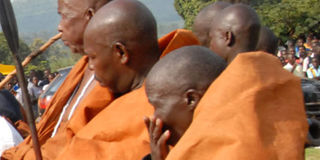When Baganda cast the spirit of death away

Bark cloth is an important aspect of the last funeral rites. For instance, when an heir is named, they are clothed in bark cloth and handed a spear. File photo
The last funeral rites, ‘okwabya olumbe’ among the Baganda is one of the long standing traditions still observed today.
Described as the marking of the end of the mourning period, Ow’ekitiibwa Denis Walusimbi Sengendo, the Buganda minister for culture, heritage, tourism and royal, explains: “Buganda is a progressive society and because of that, last funeral rites mark the end of the mourning period for a deceased family member.
It is crowned off by placing the heir in position to resume the duties and responsibilities of the deceased both in the family and society.”
An orderly process
Preparing the last funeral rites, like most cultural ceremonies, is a process where the clan members, in order of their hierarchical positions, are informed of the death of a fellow clan member.
There is no specific timeframe within which the last funeral rites are held from the time of burial. But in case the deceased held a high status in the clan, it calls for urgency in a bid to keep his office and responsibilities in motion.
Walusimbi reveals that the family of the deceased (ab’enyumba) embark on a process of announcing the death of their member (okutambuza olumbe) to the different clan offices in order of their hierarchy from; ow’olunyiriri, ow’omutuba, ow’essiga, ow’akasolya, Katikkiro up to the Kabaka.
In most cases though, many stop at the second level, according to their wealth and placing in society, while others actually continue up to the Katikkiro. But in both cases, the information finally reaches the Kabaka through his representatives.
It is after that, that a delegation headed by a chief celebrant (omusumisi) is assigned from the clan head to conduct the ceremony. It should be noted that if one doesn’t follow this procedure, the rites are considered null and void by the clan leaders.
On the eve of the ceremony
A day before the actual ceremony, family members, friends, in-laws and other well-wishers come to the venue of the last funeral rite for a vigil. A meeting is held where the heir is discussed, his duties and responsibilities outlined and the will of the deceased read.
“This is done to clear any confusion and misunderstandings that may arise in the morning when installing the heir,” Charles Kamulegeya, the head of Luganda department Mbogo Schools, says. A separate hut (Lwayaba) is also set aside for whoever will come after the last funeral rites are performed, to be a mourning place for the deceased.
The rites (okwaabya olumbe)
In the wee hours of the morning, all family members enter inside the house and shut the door. The family leader calls the congregation to order and the ritual of ‘okufulumya olumbe’ begins. A son of the daughter of the deceased (omukeezi) comes and knocks on the door carrying a gourd of local brew which he serves to the members in the house.
It is believed that this son clears bad omen from the house upon being the first entrant. The heir then leads the procession out of the house amidst ululations, as local brew is being served to the rest of the congregation.
From there on, a phase of celebration and merrymaking is opened, with drums sounding more vibrant than before and dancers together with the entire congregation dancing with vigor and energy to a new beginning.
These celebrations continue after the installation of the heir, accompanied by a great feast of food, which is prepared throughout the night and alcohol. Actually, no one is allowed to cry while mourning the deceased after this as it is considered a sign of bad luck to the heir.
Walusimbi, however, points out that today, some aspects of the funeral rites have changed.
Previously, the main celebrant would come at the venue of the funeral rites about a week before, to interact with the family of the deceased, induct the heir and tell him his responsibilities, and what is expected of him. In this process, he would also solve any family wrangles or misunderstandings pertaining inheritance.
Today, he only comes on the day of the funeral rites, and usually leaves after installing the heir.
Also, the deceased in his/her will was supposed to indicate not just the heir but also the aide, a thing which is no longer done, or just done by a few. A man could only have a male heir and vice versa but today, daughters can become their father’s heir.
Installing the heir
“Normally the heir is indicated in the deceased’s will, but if a will wasn’t left in place, family members hold a meeting with the clan delegation and decide on who should be the heir. Girls have an upper hand in this since they are considered unbiased,” Walusimbi says.
If the heir is a woman, the installation is done inside the house, after which, she is brought outside. The reverse is true. The heir is briefed on the task ahead of him and general counselling given to him. Clad in bark cloth (ekifundikwa), a spear and rod are entrusted with him as a sign of authority.
The heir is to work hand in hand with an aide (Lubuga) (usually reflected in the will) who should be a woman that is not pregnant. Dressed in bark cloth, a knife and a basket are also entrusted with her as a sign of a food provider.




